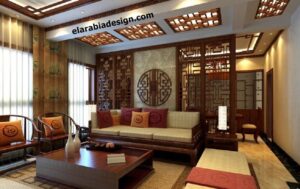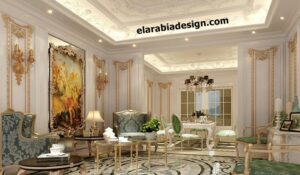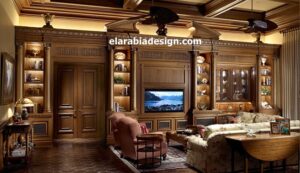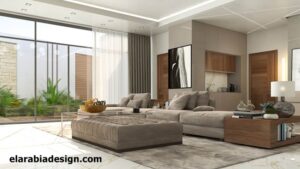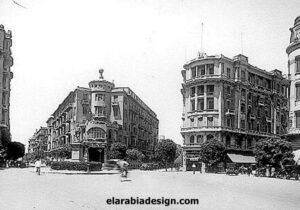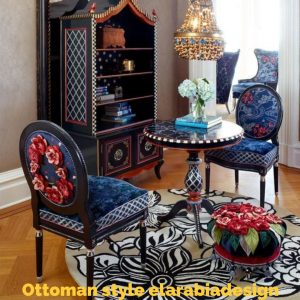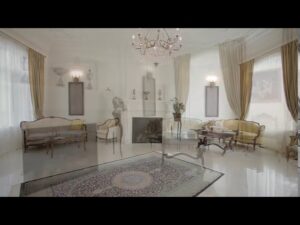محتوي المقال
The Chinese style in interior design won the admiration of many around the world, as the Chinese decoration did not take any design from European civilizations, rather the Europeans were the ones who took from the Chinese design, as the Chinese architectural design closed in on itself, so we will talk in today’s article about Chinese style in interior design in detail.
But first, you know the answer to the question, why do I deal with the interior designer Mohamed Moumia without anyone else??
The answer is in this video
Advantages of hiring an interior designer, Mohamed Moumia:
Submission of suggestions: Mohamed Moumia works as a professional interior designer to present his innovative and creative proposals to make optimal use of the interior spaces. He has experience and art in transforming ordinary spaces into distinctive and attractive places.
Follow-up and work: Once the best proposal is selected and approved by the owner, Mohamed Moumia works on the project continuously. Carefully follows up on the project and ensures that the design is executed in an accurate manner according to the owner’s vision.
Submitting Suggested Modifications: Mohamed Moumia knows that interior design projects often need modifications to achieve the desired result. Therefore, he works with the owner to determine the number of modifications that are acceptable after the completion of the project, and works to implement the modifications in a timely manner.
Delivery: Upon completion of the work, Mohamed Moumia presents the project in the form of a visual design file, such as a PDF containing collages showing the final design. It is also possible to submit a short video showing the design in 3D, and gives a clear idea of the final project.
Commitment to style and integrity: Mohamed Moumia ensures that the general architectural style of the area or space being designed is maintained. It also pays great attention to safety and security factors, ensuring a safe and comfortable indoor environment.
Experience and Distinction: Mohamed Moumia has more than 18 years of experience in the field of interior design. He is an accredited Egyptian TV designer, with an excellent reputation and proven experience in his field.
In short, Mohamed Moumia represents a distinguished and professional interior designer with creativity and experience in transforming interior spaces into beautiful and functional spaces. Seeks to achieve the owner’s vision and to provide projects that meet his needs and exceed his expectations.
call now

Chinese style history
- Interest in Chinese life arose among Europeans at the end of the 17th century. At this time, they became acquainted with the ceramics brought by early merchants from China.
- This was the beginning of Chinese Rococo in Europe.
- Architects created pagoda-style gazebos, and the house and rooms were decorated with screens made of silk fabrics as well as vases and fans.
- At first everything was superficial, they fantasized more, because they knew very little about the traditions of the Celestial Empire.
- The second phase of Chinese interior fashion began at the turn of the twentieth century.
- Since then, the traditional Chinese style of interior design has not only been used for decorative elements. Feng Shui teachings are observed in the arrangement of furniture, they know and honor the traditions and customs of the Celestial Empire.
- All this brings exotic notes and a special atmosphere to the house.
Chinese style in interior design
- The Chinese style is one of the ancient arts, originating in a civilization considered one of the oldest in the world, dating back to about five thousand years BC.
- This decoration is still popular in the market for many reasons, including that it is comfortable to look at on the one hand, and gives the place spaciousness and spaciousness on the other hand.
- One of the most important features of Chinese decoration is that it is characterized by creativity and sophistication, as its lines contributed to adding the distinctive features of each of its ancient and modern eras.
- It is characterized by simplicity, calmness and harmonious colors.
- Each piece has its own distinctive personality, and thus its location that suggests elegance and sophistication.
Chinese style colors
- The colors used in this style have a deeper meaning than we can imagine, as the colors of nature appear to a large extent, we find white, sugar, yellow, herbal green, dark red, and dark black.
- As for the furniture, it is made of very luxurious types of wood (red rosewood).
- His pieces of furniture are small and low and this is evident in the designs of the tables.
- It is also distinguished by wood carvings, such as the dragon’s head and the lotus flower, because of their well-known connotations in Chinese civilization.
- The furniture is upholstered in cotton, linen, and silk fabrics, and motifs common in the Chinese style are added.

Chinese style furniture
- The most important pieces of furniture that stand out greatly in the Chinese style is the hand-made partition (wooden partition), which consists of a bamboo frame and a large piece of rice paper inside with inscriptions and symbols of nature and palaces.
- As for the lighting, it is usually dim and comfortable, and paper lanterns are among the most popular ways of lighting with a wooden frame or a circular paper lantern suspended in the center of the room.
- The Chinese style was also famous for its manual skills, and this was evident through the accessories used, the most important of which is the Chinese porcelain, which was famous all over the world in many shapes and sizes decorated with distinctive motifs and inscriptions symbolizing the Chinese.
- We also do not lose sight of the importance of silk pillows in accessories and luxurious Chinese carpets, which are distinguished by their elegance and high quality.
Differences between Chinese style and Japanese interiors
The following can be said about the differences:
- The distribution of space, building furniture, and the characteristics of the color palette in Chinese interiors are governed by the principles of feng shui.
- In the Chinese color palette, symbolism appears and reflects myths and religious beliefs.
- The Japanese are dominated by neutral shades against a background of light tones.
- The Chinese style is characterized by an abundance of decorative elements and accessories, the Japanese prefer simplicity.
- Having learned the energy of the building, you should determine the space, guided by the rules of Feng Shui.
- Then use traditional decorative elements.
- You can just make a design, focusing on accessories, without changing layouts and arrangements.
Conceptual features in the Chinese style
- The Chinese-style residences are designed with simplicity and clarity.
- Not bulky pieces of furniture with low legs.
- Intarsia elements in the form of wood inlays adorn the fronts of cabinets and cupboards.
- Sliding screens with thoughtful and discreet accessories.
Finishes and materials are in the Chinese style
- Any room in Chinese design is finished using exclusively natural materials.
- Bamboo ranks first among materials.
- It is versatile and affordable.
- They often resort to using Manchurian walnut, straw, oak, redwood, and sandalwood.
- The floors are dark wood or a rich red.
- In addition, you can choose bamboo flooring or large tiles.
- To rest the feet, in addition to decorating the floor, they use mats and carpets with images of dragons, characters from fairy tales and temples.
- To decorate the walls, you can use paint, wallpaper, plaster or wood panels.
- It was the Chinese who decorated their homes with the first rice paper wallpaper.
- Therefore, wallpaper for Chinese interiors is often chosen as the material for wall decoration.
- Chinese roofs are a symbol of the sky, so they should be given special attention.
- Ceiling finishing for small rooms involves whitewashing or painting using carved wooden borders or edgings with hieroglyphs.
- Spacious rooms give plenty of room for imagination.
- You can make a multi-level ceiling with lighting and decorate it in the traditional Chinese style.

Chinese architectural style
Chinese-style furniture for modern interiors of any premises must meet certain requirements:
- In production, only dark species of natural wood are used.
- Only squatting objects are allowed.
- Covering is multi-layer lacquer or red paint with patriotic motifs.
- The room is furnished with sofa, lacquer chairs, tea table, wardrobes and side tables wide and deep but not long.
Conclusion
We advise you to know the difference between an interior designer and other?
- Interior designer job The interior designer is responsible for designing and utilizing the interior spaces of a home to meet the basic needs of its residents.
- That is, it depends on employing the place appropriately to meet the purpose. It is typical for an interior designer to have an associate degree in their field.
- Interior design is taught in the Colleges of Fine and Applied Arts and Architecture. Therefore, he relies on academic science in the home design process.
- The reliance of interior designer, interior designer Mohamed Moumia, on engineering principles in his work does not mean that he ignores the aesthetic form.
- As one of his tasks is to design the decoration and choose the style as well, as this matter falls within the goal of employing the spaces that he achieves.
- As for the interior designer, he is the person who revives the aesthetic and artistic side of the interior design.
- He cares more about choosing colors, designing furniture, and adding aesthetic elements.
- Therefore, we advise you to contact elarabiadesign
call now
What is Chinese style interior design?
Chinese style interior design refers to a style of decorating a room or a building that is influenced by traditional Chinese aesthetics and culture. This style is characterized by a strong connection to nature, the use of natural materials like wood, bamboo, and stone, as well as harmonious color combinations, and a focus on balance and symmetry.
Elements of traditional Chinese architecture and furniture can be incorporated into a Chinese style interior design, such as carved wooden panels, lattice screens, lanterns, and scrolls with calligraphy or paintings. The use of red and gold is common in this style, as these colors are believed to bring good luck and prosperity. The furniture is often arranged in a way that creates a sense of flow and continuity, and there is a strong emphasis on comfort and functionality.
Overall, Chinese style interior design aims to create a peaceful and harmonious environment that reflects the traditional Chinese cultural values of balance, simplicity, and harmony with nature.
What are the characteristics of traditional Chinese interior?
Traditional Chinese interior design is characterized by the following elements:
Nature-inspired themes: Traditional Chinese interiors often draw inspiration from nature and feature natural materials such as bamboo, wood, and stone. There is often a strong emphasis on creating a harmonious balance between the interior and the exterior.
Use of Red and Gold: Red and gold are considered lucky colors in Chinese culture and are often used in traditional Chinese interiors. These colors are often used as accents in furniture, textiles, and decor.
Harmonious color combinations: Traditional Chinese interior design emphasizes the use of harmonious color combinations, typically neutral shades of beige, black, and white, accented by the use of red and gold.
Use of Symbolism: Traditional Chinese interiors often include symbols and motifs that are significant in Chinese culture, such as the use of the dragon, phoenix, and other creatures from Chinese folklore.
Emphasis on balance and symmetry: Balance and symmetry are important principles in traditional Chinese interior design. Furniture is often arranged in a symmetrical manner, and spaces are designed to create a sense of balance.
Incorporation of Traditional Chinese Architecture: Elements of traditional Chinese architecture, such as wooden beams and columns, carved wooden panels, lattice screens, and arched doorways, can be incorporated into the design of a traditional Chinese interior.
Use of Soft Lighting: Traditional Chinese interiors often feature soft, warm lighting, such as lanterns, candles, or lamps, to create a relaxing and inviting atmosphere.
Overall, traditional Chinese interior design emphasizes simplicity, balance, and harmony, and seeks to create an environment that promotes peace and tranquility.
What is modern Chinese interior design?
Modern Chinese interior design refers to a contemporary interpretation of traditional Chinese design principles, incorporating modern materials, technologies, and design elements while retaining the essence of Chinese culture and aesthetics.
Some of the key characteristics of modern Chinese interior design include:
Blend of Traditional and Modern Elements: Modern Chinese interior design often incorporates traditional Chinese elements, such as the use of natural materials, harmonious color combinations, and symbolic motifs, but reinterpreted in a more contemporary style.
Use of Minimalism: Modern Chinese interior design often emphasizes minimalism, with clean lines, neutral colors, and simple, understated furnishings.
Use of Technology: Modern Chinese interior design often incorporates the latest technologies, such as smart home systems and LED lighting, to create functional and energy-efficient spaces.
Use of Natural Light: Modern Chinese interiors often feature large windows and skylights to allow for an abundance of natural light, creating bright, open spaces that are in harmony with nature.
Incorporation of Greenery: Plants and other forms of greenery are often incorporated into modern Chinese interior design, either as living elements within the interior or as imagery in decorative elements such as wall art and textiles.
Focus on Sustainability: Modern Chinese interior design often incorporates sustainable materials and practices, such as the use of renewable energy sources, environmentally friendly products, and green building techniques.
Overall, modern Chinese interior design combines traditional Chinese aesthetics and culture with contemporary design elements to create spaces that are functional, beautiful, and in harmony with the environment.
What are the 4 types of interior design?
Interior design encompasses a wide range of styles, but some of the most common types of interior design can be broadly categorized into the following four categories:
Traditional: Traditional interior design is characterized by the use of classic furnishings, elegant textiles, and classic patterns. This style often incorporates elements of historical design movements, such as Victorian, Georgian, and Regency, and is characterized by a warm, comfortable, and classic feel.
Modern: Modern interior design is characterized by clean lines, simple forms, and a minimalistic aesthetic. This style often incorporates cutting-edge materials, such as glass, steel, and concrete, and makes use of neutral colors and simple, uncluttered spaces.
Contemporary: Contemporary interior design is characterized by a fluid, ever-evolving style that incorporates elements of modern design. This style is often marked by a focus on functionality and comfort, and often incorporates bold colors, innovative materials, and eclectic furnishings.
Eclectic: Eclectic interior design is characterized by the combination of elements from different design styles and time periods. This style is often marked by a playful, eclectic mix of furniture, textiles, and decor, and is known for its unique, personal touch.
These are just a few of the most common types of interior design, and there are many other styles and sub-categories that can be explored. Ultimately, the best type of interior design for any given space will depend on a variety of factors, including personal style, budget, and the intended use of the space.
call now

